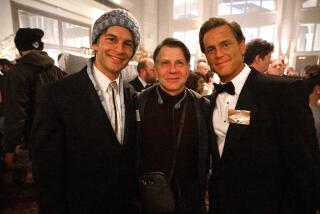Ecce Homo
- Share via
Is there a history of homophobia in the West? Surely few would deny it. Still, it should not surprise us that the subject has received little attention, academic or otherwise--at least, by this name. For thousands of years, as Byrne Fone’s substantial but frustratingly uneven book illustrates, anti-gay sentiment has been as omnipresent as the air, as invisible and as rarely called into question.
In his introduction, Fone contrasts the attention paid to the history of homosexuality with the dearth of comment on his chosen topic: anti-homosexual prejudice, rhetorical, legal or social. The reason for this dearth is obvious: Homosexuality and homophobia have danced a deux throughout their long existences. Every effort to consider one in isolation from the other is doomed. Whether we like it or not, the cultural understanding of homosexuality has stemmed from the ranting of homophobes, the quieter muttering of a few liberals and the defiant rhetoric and behavior of a handful of sexual radicals.
Homosexuality, then, we can imagine as a triangular term stretched around these three crude groupings. Think of it as resembling New York’s Flatiron building: fragile, slim, almost invisible from one perspective and, from another, massive, overwhelming, almost on the march.
Perspective is key, and its variance over time is what gives Fone’s book some sense of narrative. Still, though the recent past gives some grounds for optimism, the topic of homophobia necessarily prescribes a pretty depressing read. Four brief chapters on same-sex mores in Greek and Roman civilizations lead Fone swiftly into the dismal mire of two millenniums of Judeo-Christian bigotry.
The last 700 years cast the darkest shadow of homophobia. Since the first recorded burning at the stake of a “sodomite”--historically often a less precise term than today--in 1292, the severest punishments and acts of violence have been dealt to lesbians, gays and the many others who variously threatened to overturn an apple cart of strictly enforced gender roles laboriously introduced by Adam and Eve.
Fone’s comprehensive rebuttal of any defense of homophobia that relies on biblical sources impresses. Niceties of theological scholarship--especially readings of the Sodom and Gomorrah story--are intelligently explored. Ironically, the misreadings started by way of a misinterpretation of the Hebrew verb yadha (to know). But the truth here pales beside the reality of the forces--political, military, social--exerted behind such errors and the misery consequently endured over time.
If the Bible brings out the activist in Fone, the chapters on classical culture are comparatively inert. Keen, perhaps, not to eulogize Greek culture unconditionally, as many did in the Renaissance and the 19th century, Fone is cautious over which forms of sexual relationship were held to be legitimate. One wonders if Fone’s scholarship in these early chapters is out of date. Kenneth Dover’s “Greek Homosexuality” (1978)--solid but dated--is relied upon throughout. Recent scholarship scarcely features--especially Michel Foucault’s vital “The Uses of Pleasure.” James Davidson’s marvelous recent corrective to Foucault’s idealism, “Courtesans and Fishcakes,” is mentioned, though credited to “James Henderson.” Fone is reluctant to pursue Davidson’s bold claim that the Greeks did not “see a gulf between a desire to penetrate and a desire to be penetrated.” He merely calls the idea “intriguing.”
*
Early Christians reacted angrily to the Hellenic example, concentrating their fire on its sanctioning of pedophilic and ephebophilic relations (the first with pre-pubescents; the second with older adolescents). In this period, Fone draws heavily upon the late John Boswell’s still indispensable “Christianity, Social Tolerance and Homosexuality” (1980). As Boswell first showed, in the second century, Clementine of Alexandria warned against “fruitless sowings” of the seed and was the first to invoke natural--that is, procreative--law. Nature, Clementine argued, “should be obeyed, who discourages [such things] through an arrangement of the [body] parts which make the male not for receiving the seed but for sowing it.”
Clementine’s ideas set the tone for both ethical and aesthetic hostility to same-sex relations for the next 1,800 years. They also underlined the strong ongoing link in popular thought between the identity of the pervert or sodomite and the dangers of behavior deemed inappropriate to one’s gender. Sodomites, Clementine insisted, could be identified by an untoward lack of facial hair or by effeminate conduct: “He who disowns his manhood by day will surely be shown to play the woman at night.” The depravity of homosexuality would henceforth be considered starkest in those men who allowed themselves to be sexually taken by other men and so conquered by lust itself.
It is a small step from this to the 19th century mania for classifying sexual types and the related interest in pathologizing sexual deviants through their social conduct, their physiognomy and even by way of phrenology, the “science” of head shapes. Twentieth century signs would include an inability to whistle, a love for the color green (or mauve) and, as Edmund White once noted, the tendency to smoke a cigarette “like” a woman.
At an early stage, the connection between the oppression of homosexuals, especially men, and the social and sexual suppression of women was established. Hence, so much later, the ambivalent interest of fin de siecle writers--those posing as degenerate and otherwise--in biblical stories concerning wanton women like Salome and their inevitable punishment.
One constant of homophobic thinking is its curious illogicality. The Greek prelate Basil, in the 4th century, considered same-sex desire horrifying. It was, however, so overwhelmingly tempting a quill among the devil’s arsenal that he spoke against the sin in the following terms: “When a young man converses with you . . . make your response with your head bowed, lest perchance by gazing fixedly in his face, the seed of desire be implanted in you by the wicked sower.” As Fone comments, “Basil seems to know just how attractive a boy can be.” If gay desire is an illness, the eyes, it appears, have it. A similar nervousness probably led Emperor Theodosius, in 393, to ban the Olympic Games.
In discussing Europe during and after the Renaissance, Fone responds to the surfeit of material by making some odd choices. The English king Edward II is glancingly referred to but is deemed “familiar.” The assassination of France’s Henry III is related in full, however. Later, Fone dismisses well-informed comment on the private life of William Beckford, author of the codified Gothic novel “Vathek” as speculation. He should look up details of Beckford’s harem of young male servants in the recent biography by Timothy Mowl.
Still, there is space for fascinating lesser known material, such as the 12th century poem “Debate Between Ganymede and Helen.” By design homophobic, this poem nonetheless contains many witty retorts by Ganymede, Zeus’ catamite, to the straitlaced Helen. “[M]en who have ruled the world and held the highest offices . . ,” he says, pointing to the popularity of homosexuality among great leaders and thinkers, “don’t shun the silky crotches of boys.”
It is compelling how attitudes about homosexuality came to be informed by class considerations. In particular, the increasing visibility of the unmentionable crime seems bound by the rise in the fortunes of the bourgeoisie and related cultural forms like the novel. Some early comprehensive, if anti-gay, portraits feature in the works of Tobias Smollett. Later, Victorian middle-class ethics conveniently thought of the vice in terms of those “above” them manipulating those “below.” In the 1930s, the Auden circle earned the epithet “the Homintern,” a pun on “Comintern,” which reflected the sense that an elite informed circle of queers dared to live according to different moral values from the rest of us. This latter-day form of noblesse oblige, clearly far from flattering, illustrates how Ganymede’s earlier invocation of the great and the good of the gay past--often repeated over history, as much in the works of Oscar Wilde as in those of Larry Kramer--can backfire. The accusation of moral turpitude is nonsense but poisonous. Because social taboo and legal statutes made openness unacceptable and criminal, it was inevitable that a suspicion of superior or aloof conduct in the homosexual could gain widespread credence.
The last sections of “Homophobia: a History” are weakest, as Fone unwisely separates the New World from the Old while simultaneously having to be ever more selective. The 20th century, for Fone, effectively belongs to the United States. Britain’s Section 28 is ignored. This relic of Margaret Thatcher’s government, the definitive framing of homophobic thinking in law, legislated against the use of local government funds to “promote” homosexuality. Does being something promote it? Does knowing about it? Speaking of it? All run scared.
*
Ultimately, “Homophobia: A History” is most enjoyable in its incidental details, such as the 15th century German coinage of the word florenzen, meaning to bugger, in honor of the seemingly fallen Italian city. And who would guess that Venetian pastry makers would play host to “games, drinking, many dishonesties and sodomy”?
The most compelling moments, though, occur when coincidence nudges the past against the present. Savonarola, the reformist preacher, was parading his “reformed” boys around Florence’s Piazza della Signoria 500 years before our own evangelist “rescue” movement. And when a Dominican monk assassinated Henry III, he anticipated the awful litany of our own times: Victims Teena Brandon and Matthew Shephard and David Copeland, the Londoner who bombed the gay pub the Admiral Duncan and was recently sentenced to six life imprisonments. He killed three people, including one pregnant woman, and injured many more. Homophobia’s history is only now being mapped. But, as long as there are gay men and women among us, I suspect it will endure. Knowing its past may ensure we don’t overlook its presence. *
More to Read
Sign up for our Book Club newsletter
Get the latest news, events and more from the Los Angeles Times Book Club, and help us get L.A. reading and talking.
You may occasionally receive promotional content from the Los Angeles Times.








